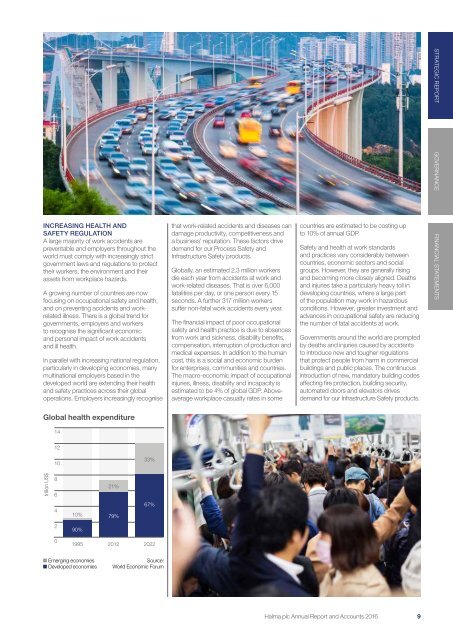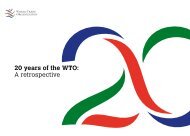You also want an ePaper? Increase the reach of your titles
YUMPU automatically turns print PDFs into web optimized ePapers that Google loves.
INCREASING HEALTH AND<br />
SAFETY REGULATION<br />
A large majority of work accidents are<br />
preventable and employers throughout the<br />
world must comply with increasingly strict<br />
government laws and regulations to protect<br />
their workers, the environment and their<br />
assets from workplace hazards.<br />
A growing number of countries are now<br />
focusing on occupational safety and health,<br />
and on preventing accidents and workrelated<br />
illness. There is a global trend for<br />
governments, employers and workers<br />
to recognise the significant economic<br />
and personal impact of work accidents<br />
and ill health.<br />
In parallel with increasing national regulation,<br />
particularly in developing economies, many<br />
multinational employers based in the<br />
developed world are extending their health<br />
and safety practices across their global<br />
operations. Employers increasingly recognise<br />
that work-related accidents and diseases can<br />
damage productivity, competitiveness and<br />
a business’ reputation. These factors drive<br />
demand for our Process Safety and<br />
Infrastructure Safety products.<br />
Globally, an estimated 2.3 million workers<br />
die each year from accidents at work and<br />
work-related diseases. That is over 6,000<br />
fatalities per day, or one person every 15<br />
seconds. A further 317 million workers<br />
suffer non-fatal work accidents every year.<br />
The financial impact of poor occupational<br />
safety and health practice is due to absences<br />
from work and sickness, disability benefits,<br />
compensation, interruption of production and<br />
medical expenses. In addition to the human<br />
cost, this is a social and economic burden<br />
for enterprises, communities and countries.<br />
The macro-economic impact of occupational<br />
injuries, illness, disability and incapacity is<br />
estimated to be 4% of global GDP. Aboveaverage<br />
workplace casualty rates in some<br />
countries are estimated to be costing up<br />
to 10% of annual GDP.<br />
Safety and health at work standards<br />
and practices vary considerably between<br />
countries, economic sectors and social<br />
groups. However, they are generally rising<br />
and becoming more closely aligned. Deaths<br />
and injuries take a particularly heavy toll in<br />
developing countries, where a large part<br />
of the population may work in hazardous<br />
conditions. However, greater investment and<br />
advances in occupational safety are reducing<br />
the number of fatal accidents at work.<br />
Governments around the world are prompted<br />
by deaths and injuries caused by accidents<br />
to introduce new and tougher regulations<br />
that protect people from harm in commercial<br />
buildings and public places. The continuous<br />
introduction of new, mandatory building codes<br />
affecting fire protection, building security,<br />
automated doors and elevators drives<br />
demand for our Infrastructure Safety products.<br />
STRATEGIC REPORT GOVERNANCE FINANCIAL STATEMENTS<br />
Global health expenditure<br />
14<br />
12<br />
10<br />
33%<br />
trillion US$<br />
8<br />
6<br />
21%<br />
4<br />
10% 79%<br />
67%<br />
2<br />
90%<br />
0<br />
1995<br />
2012 2022<br />
■ Emerging economies<br />
■ Developed economies<br />
Source:<br />
World Economic Forum<br />
<strong>Halma</strong> plc Annual Report and Accounts <strong>2016</strong> 9

















